AMD CPUs in 2022: Zen 4 in Second Half, Ryzen 7 5800X3D with V-Cache by Spring
by Dr. Ian Cutress on January 4, 2022 10:42 AM EST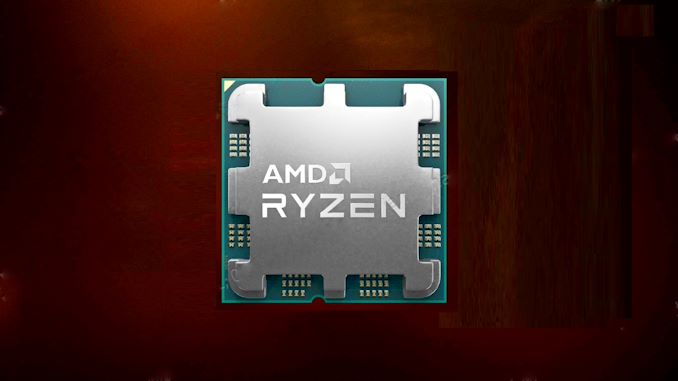
One of the things I look forward to every year is whether the major companies I write about are prepared to showcase their upcoming products in advance – because the year starts with the annual CES trade show, this is the perfect place. A company that’s able to present its 12-month portfolio comes across as confident in its ability to deliver, and it also gets the rest of us salivating at the prospect of next-generation hardware. This time around AMD steps up to the plate to talk about its new V-Cache CPU coming soon, and its new Zen 4 platform coming in the second half of the year.
Now with V-Cache! One Sole CPU: Ryzen 7 5800X3D
Every CPU has levels of internal memory, known as cache, which starts as a bank of ‘Level 1’ fast but small memory, rising up to a ‘Level 2’ medium-sized medium speed memory, and then a ‘Level 3’ larger sized slower memory. Beyond this there’s the main DDR memory, which is super big, but super slow in comparison – main memory is 100x slower to access, but can hold a lot more data.
Last year AMD announced that it had been working on stacked onboard memory in the form of cache. This V-Cache concept took one of the standard 8 core chiplets from the Ryzen 5000 series, which already had 32 MB of L3 cache, and stacked on top of it another 64 MB of L3 cache, giving a total of 96 MB. Stacking chips is difficult, and AMD has been working with TSMC to productize this advanced packaging technique.
The main 8-core chiplet, built on TSMC 7nm, measures 82 mm2. This extra stacked chiplet is only 36 mm2, and sits directly above the cache already on the chip, so it does not cover the cores. The extra 64 MB of L3 cache chiplet is manufactured on a version of TSMC 7nm that is optimized for cache density, and so AMD has placed 64 MB on top of 32 MB directly. The cores are not covered for thermal reasons – the cores are where the power is used, and so thermal spaces are placed on top to make the top of the combined chip fully flat.
AMD stated last year that it would be manufacturing consumer and enterprise versions of this increased cache in 2021 for launch in 2022. At the Data Center event last year in November, AMD announced the version that would go into servers, and called it Milan X. For consumers, AMD is announcing today what this increased cache version of Ryzen looks like. Introducing, the Ryzen 7 5800X3D.
AMD is only going to launch a single Ryzen version of its V-Cache technology, using the Ryzen 7 5800X as a base. This means the chip is 8 cores, 16 threads, and 105 W TDP just like the regular R7 5800X, but with 96 MB of L3 cache now rather than 32 MB. It will run at 3.4 GHz Base, 4.5 GHz boost, be overclockable, and work in AMD 400-series and 500-series motherboards.
| AMD Ryzen 5000 Series Processors for Desktop Zen 3 Microarchitecture (Non-Pro, 65W+) |
|||||||||
| AnandTech | Core/ Thread |
Base Freq |
1T Freq |
L3 C$ |
IGP | PCIe | TDP | SEP | |
| Ryzen 9 5950X | 16 | 32 | 3400 | 4900 | 64 MB | - | 4.0 | 105 W | $799 |
| Ryzen 9 5900X | 12 | 24 | 3700 | 4800 | 64 MB | - | 4.0 | 105 W | $549 |
| Ryzen 9 5900 | 12 | 24 | 3000 | 4700 | 64 MB | - | 4.0 | 65 W | OEM |
| Ryzen 7 5800X3D | 8 | 16 | 3400 | 4500 | 96 MB | - | 4.0 | 105 W | ? |
| Ryzen 7 5800X | 8 | 16 | 3800 | 4700 | 32 MB | - | 4.0 | 105 W | $449 |
| Ryzen 7 5800 | 8 | 16 | 3400 | 4600 | 32 MB | - | 4.0 | 65 W | OEM |
| Ryzen 7 5700G | 8 | 16 | 3800 | 4600 | 16 MB | Vega8 | 3.0 | 65 W | $359 |
| Ryzen 5 5600X | 6 | 12 | 3700 | 4600 | 32 MB | - | 4.0 | 65 W | $299 |
| Ryzen 5 5600G | 6 | 12 | 3900 | 4400 | 16 MB | Vega7 | 3.0 | 65 W | $259 |
| Ryzen 3 5300G | 4 | 8 | 4000 | 4200 | 8 MB | Vega6 | 3.0 | 65 W | OEM |
The processor will launch in the Spring (March/April we think), and exact pricing is yet to be announced.
For those that have been following AMD’s V-Cache news over this past year, I bet you have exactly the same questions I did when AMD first briefed us on this announcement. Here is a summary of the questions I asked, and my interpretations of the responses.
Why only Ryzen 7, not Ryzen 5/Ryzen 9? Because this is a new project for AMD, they want to find out how a processor like this will be welcomed into the market. A lot of users (myself included) expected AMD to go all-in with a big 16-core version, however anything Ryzen 9 requires two chiplets, and adding the extra V-Cache does require an extra cost in silicon and packaging. During a semiconductor shortage, I was told that this is the best way to get it into the hands of many people while also not in the super high-cost bracket. It also means one single unified 96 MB of L3 cache, without having to deal with two chiplets worth which might not be optimized immediately. Future versions of V-Cache on next-generation products may be expanded to other Ryzen members of the family.
The frequencies are lower than the regular 5800X? The cache does add a few watts to the power both in terms of idle and load. Rather than bin a stricter chiplet, the decision was made to reduce the frequency a little, but still allow overclocking. The chip, while listed at 105 W, still has the 142 W package power tracking for motherboards that support it.
Who is this chip for? The focus is on users playing video games over anything else. The extra cache is meant to help with communications with discrete graphics cards, offering additional performance above the regular R7 5800X. Productivity workloads are less likely to be affected, and for those users the regular Ryzen CPUs are expected to be better. The Ryzen 7 5800X3D is designed to be the ‘World’s Fastest Gaming Processor’ (when compared to the 5900X and 12900K).
In terms of those performance metrics, AMD is quoting:
- From 1.0x to 1.4x at 1080p High vs Ryzen 9 5900X + RTX3080 (15% average)
- From 0.98x to 1.2x at 1080p High vs Core i9-12900K (DDR5) + RTX3080
Both systems were running Windows 11.
The critical element here I think is going to be the price. As I’m writing this piece, I can find the following prices:
- Ryzen 5 5600G (6C/12T*): $240
- Ryzen 5 5600X (6C/12T): $290
- Core i5-12600K (6P+4E*): $300
- Ryzen 7 5700G (8C/16T*): $340
- Ryzen 7 5800X (8C/16T): $369
- Core i7-12700KF (8P+4E): $390
- Ryzen 9 5900X (12C/24T): $540
- Core i9-12900KF (8P+8E): $590
- Ryzen 9 5950X (16C/32T): $730
Even though AMD is promoting the Ryzen 7 5800X3D to be higher performance than the 5900X in gaming, if it goes anywhere north of $500, it might be badly received. At $500, it would be a +$130 add-on from the regular Ryzen 7 5800X. Are users willing to pay almost 30% more for triple the L3 cache for up to 15% more performance in gaming? Or is this just simply a play for the world’s fastest gaming processor, regardless of cost?
Don’t get me wrong here, I think the technology is great. But in order for AMD to keep the same margins, it might be more expensive than people think. I’m looking forward to getting it in hand for review – let us know what sort of tests you want to see.
Coming 2H 2022: Zen 4 on 5nm, with AM5, DDR5, and PCIe 5.0
Perhaps not that surprising given all the information from last year, AMD has confirmed that Zen 4 based Ryzen CPUs coming in 2022 will be built on TSMC’s 5nm process (we assume N5), will be built on the AM5 socket, and feature DDR5 as well as PCIe 5.0. What we get new out of this disclosure are images of the new socket, and a render of the CPU form factor.
With AM5, AMD is going to move to a Land Grid Array (LGA) style of processor, similar to Intel, eliminating the Pin Grid Array (PGA) that has been used on the current Ryzen desktop processors. AMD is no stranger to LGA, given that its EPYC enterprise processors and Threadripper processors both use it. The new AM5 socket is a 1718 pin design, with the pins in two orientations:
If this sort of socket looks familiar to any of you, it’s because it appears to be a denser version of AMD’s old socket F back in 2006-2010. While that old socket at 1207 pins for Opteron enterprise processors, this one has 1718, so you’ll see us refer to it as LGA1718. Compared to Intel’s 12th Gen Core processors that use an LGA1700 socket, both the major platforms are around the same number of pins.
It is worth noting that this sort of socket, like the old Socket F, means that the bottom of the Zen 4 processors will be nothing but contact pads. The use of an LGA socket means the pin density is defined at the socket level, rather than on the processor, and it’s easier to design a socket with a higher pin density. But the pin-only rear means that some of the power circuitry for the chip will be both in-package and on the top, which is handy given that AMD is also showcasing what the CPU will look like.
We’ve got another square-like CPU package, however to accommodate some of that power delivery the heatspreader has this sort of octopus arm design to it. The heatspreader is not rotationally symmetric, with the top/bottom (as shown) central arms being smaller than the left/right central arms. The processor also has two notches, one at the top and one at the bottom, just left of center to make sure that the processors are entered in the right way. There’s also that yellow arrow on the top left corner to help guide the user.
On top of showcasing the CPU and the LGA1718 socket, AMD is confirming that the AM5 platform will support AM4 coolers. This means we should expect the mounting holes for AM5 to be the same, or at least the platform to accept both old and new.
Next-Gen Ryzen, featuring Zen 4 cores, 5nm manufacturing, and the new AM5 socket, is coming to market in the second half (2H) of 2022. Core counts and everything else will come later – I suspect we’ll get a deep dive into the architecture sometime around August, at the Hot Chips industry event, or at a special AMD event around that time.


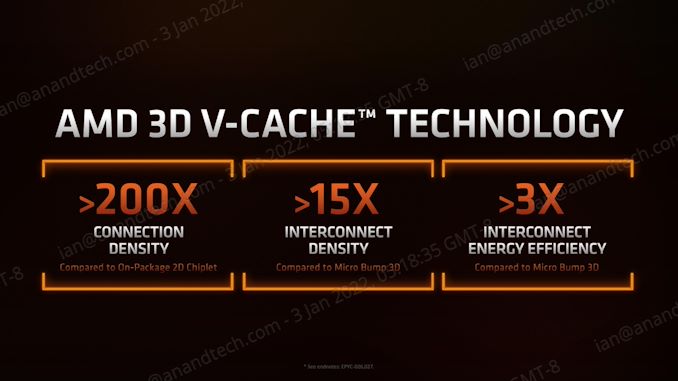
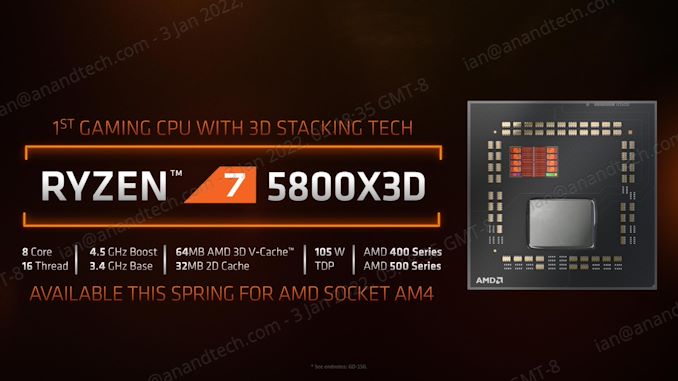

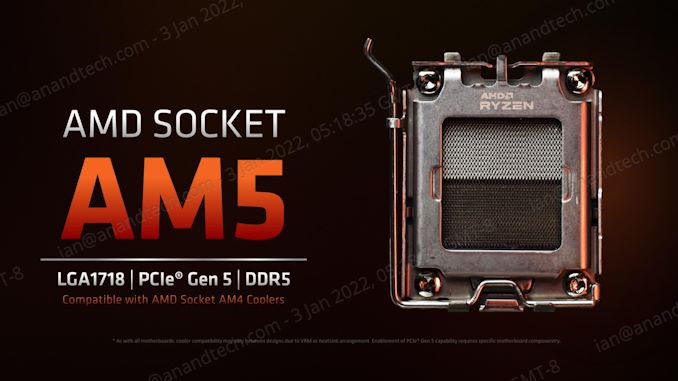
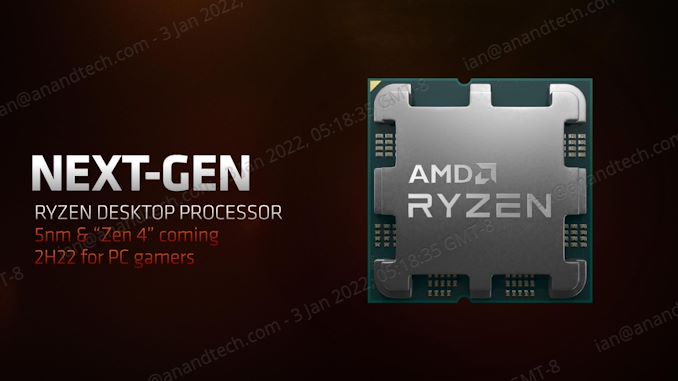








99 Comments
View All Comments
esoel_ - Tuesday, January 4, 2022 - link
My wallet is shaking in terror…Jon Tseng - Tuesday, January 4, 2022 - link
The thing that strikes me is AMD are only getting to 5nm two years after Apple ramped to volume production.I get there are difference in LP vs HPC process, die size and yield challenges (tho don’t chillers help this). But it’s crazy they have taken so long. I mean what’s the point of having a three year process advantage over the competition if it takes two years to get the parts out.
Is it just being parked behind Apple in the queue that’s the issue, or am I missing something here? I mean if it takes another two years to get to N3 then Intel will CNN e ahead next year with 4nm Meteor Lake, no?
whatthe123 - Tuesday, January 4, 2022 - link
it's because it's expensive. According to TSMC they expected 8% of all revenue to be 5nm in 2020, and at that point only Apple was on 5nm, so Apple fronted 3~4 billion dollars for 1~2 quarters worth of chips. They also invest in TSMC's expansion directly.Spunjji - Wednesday, January 5, 2022 - link
Hard to know how much of the wait is because they wouldn't get enough volume due to Apple hogging the process, how much of it is AMD waiting for the process to be mature enough for a large chip to be sold to OEMs (Apple can swallow losses like nobody else because they own everything), and how much of it is AMD's design schedule not lining up neatly with N5 availability.Blastdoor - Thursday, January 6, 2022 - link
One other factor -- maybe the most important:Because AMD's direct competition is Intel (not Apple) and they simply haven't needed TSMC 5nm to beat Intel.
It only makes sense for AMD to move to 5nm when Intel starts offering competitive products. Looks like Intel is finally doing that and so, what da ya know, AMD is now going to move to 5nm.
lmcd - Saturday, January 8, 2022 - link
It's not hard to say how much is the latter -- AMD is unwilling to redo an already-working IO die, which would be needed to support N5. There's a reason mobile SoCs are getting Zen 3+ and desktop aren't -- even that jump would probably need a notable reinvestment into an IO die that'll just be deprecated with Zen 4 anyway.Mike Bruzzone - Monday, January 17, 2022 - link
good point end of run and end of runway. mbDannyH246 - Tuesday, January 4, 2022 - link
From what we’ve seen in older Zen2 & later Zen3 chiplets the contact points for 3D stacking has been there for a while. My take on this is that this was supposed to be out a long time ago. I reckon they’ve had issues getting this working properly and manufacturable, now I think they’ve finally cracked it but AM4 is soon to be legacy, so that’s why we’ll see just one SKU on AM4 with stacking. However I do believe all the ‘learning’ for this has been done, and Zen4 will see lots of stacking options.haukionkannel - Wednesday, January 5, 2022 - link
Expensive to produce... so no point of releasing it until you need expensive "flagship" product.When 5900 is $540 and 12900KF is $590, there is marginal slot in between those.
5800X3D at $550 would be price competitive Anywhere else it would not make sense.
Mike Bruzzone - Wednesday, January 5, 2022 - link
Thank you for that observation thinking about the missing price rung between $540 5900 and $590 12900KF; $550. 32K of SRAM costs TSMC $5.40 in sand and on the pads x2 so $11.80 plus 100% mark up on extra package and test steps = $21.60 and TSMC price to AMD x2 = $43.20 (less if x1.5). On V5x full run volume all SKUs the average price from TSMC to AMD is $165 before AMD mark up to the OEM. So $165 + lets round up to $45 for 32 MB SRAM = $210 and AMD will mark up x1.5 to x2 on high to lower volume procurement means the OEM price is range $316 to $421 and then the OEM adds x1.5 = range $474 to $632 or if we average between that range $553. mb